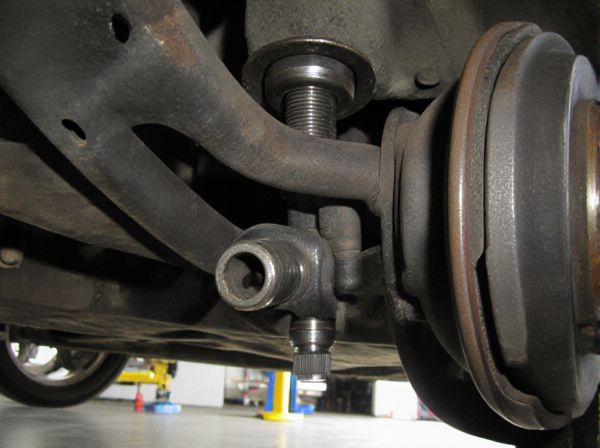
Photo illustration: U-joint Connection vs CV Joint Connection
A U-joint connection provides flexibility for transmitting torque at varying angles, commonly used in driveshafts where moderate angular movement occurs, but it may cause vibrations at higher speeds. CV joint connections, on the other hand, offer smooth and consistent power transfer through a wide range of motion without vibrations, making them ideal for front-wheel-drive vehicles and applications requiring precise wheel alignment. You should choose a CV joint if smooth rotation and maintaining constant velocity are critical for your vehicle's performance.
Table of Comparison
| Feature | U-Joint Connection | CV Joint Connection |
|---|---|---|
| Flexibility Angle | Up to 25 degrees | Up to 45 degrees |
| Motion Type | Intermittent velocity | Constant velocity |
| Durability | Moderate; requires lubrication | High; sealed and maintenance-free |
| Noise and Vibration | Higher noise and vibration at extreme angles | Low noise and smooth operation |
| Typical Use | Rear-wheel drive, older models | Front-wheel drive, independent suspension |
| Cost | Lower initial cost | Higher initial cost |
Overview: U-Joint vs CV Joint Connections
U-joint connections feature a cross-shaped pivot allowing rotational flexibility but can cause vibration at higher angles, making them common in rear-wheel-drive vehicles. CV joint connections provide constant velocity power transfer at varying angles, enhancing smoothness and are typically used in front-wheel-drive and all-wheel-drive systems. Both joints are essential for transmitting torque while accommodating suspension movement, with CV joints offering improved efficiency and reduced maintenance.
Key Differences in Design and Function
U-joint connections feature a cross-shaped pivot allowing for angular misalignment between shafts, primarily enabling rotational motion in drive shafts with variable angles, often seen in rear-wheel-drive vehicles. CV joint connections provide smooth rotational power transfer through constant velocity, accommodating more complex motion like steering angles without speed fluctuations, crucial in front-wheel-drive and all-wheel-drive systems. The fundamental design difference lies in the U-joint's ability to handle angular variability with some speed fluctuation versus the CV joint's capacity for consistent rotational speed and flexible motion paths.
How U-Joint Connections Work
U-joint connections operate by transferring rotational motion between shafts at varying angles through a cross-shaped pivot bearing that allows for flexibility and torque transmission. These joints accommodate angular misalignment by allowing the connected shafts to bend in relation to each other, essential for vehicles with driveshafts experiencing changes in alignment during movement. U-joints are preferred in applications requiring durability and resistance to torque fluctuations, such as in rear-wheel-drive vehicles and heavy machinery.
How CV Joint Connections Work
CV joint connections use a series of flexible ball bearings enclosed within a spherical housing that allows rotational movement while accommodating changes in angle between the drive shaft and the wheels. This design maintains constant rotational speed and smooth power transmission, essential for front-wheel-drive vehicles and independent suspension systems where the axle experiences up-and-down motion. Unlike U-joints, CV joints minimize vibration and joint wear by evenly distributing torque and compensating for misalignment during steering and suspension travel.
Durability and Maintenance Comparison
U-joint connections typically offer greater durability under high-torque conditions due to their robust cross-shaped design but require frequent lubrication to maintain performance and prevent wear. CV joint connections provide smoother power transmission with less vibration and require less maintenance, featuring sealed designs that protect internal components from contaminants. While U-joints excel in heavy-duty applications, CV joints are more maintenance-friendly and durable in everyday driving conditions where consistent lubrication is less feasible.
Performance in Real-World Applications
U-joint connections excel in durability and are well-suited for off-road and heavy-duty applications due to their robustness under high torque and angular misalignment. CV joint connections offer superior smoothness and consistent velocity transfer, making them ideal for front-wheel-drive vehicles and situations requiring precise steering control. Real-world performance favors U-joints in rugged environments while CV joints dominate in applications demanding reduced vibration and enhanced drivability.
Advantages of U-Joint Connections
U-joint connections offer superior flexibility in transmitting torque at varying angles, making them ideal for off-road and heavy-duty applications where shaft misalignment occurs frequently. They provide a robust and durable design with fewer moving parts, resulting in easier maintenance and longer service life under high-load conditions. U-joints also deliver consistent performance at low speeds and high torque, outperforming CV joints in rugged environments.
Advantages of CV Joint Connections
CV joint connections provide superior flexibility and consistent torque transmission at varying angles compared to U-joint connections, which enhances vehicle handling and drivability. They accommodate greater articulation without vibration, making them ideal for front-wheel-drive and all-wheel-drive vehicles where smooth power delivery is critical. The durability of CV joints under constant high-speed rotation and complex movement reduces maintenance requirements and improves overall drivetrain longevity.
Common Issues and Failure Points
U-joint connections commonly suffer from wear and tear due to lack of lubrication, causing vibrations and eventual joint failure. CV joint connections frequently experience boot cracks and grease leakage, leading to contamination and joint degradation. Both joints encounter durability challenges under extreme angles, but CV joints are generally more prone to damage from constant velocity stresses.
Choosing the Right Joint for Your Vehicle
Choosing the right joint for your vehicle depends on factors like flexibility, load capacity, and application type. U-joint connections excel in handling high torque and angular misalignment in trucks and off-road vehicles, while CV joint connections provide smoother, constant velocity rotation ideal for front-wheel-drive cars and independent suspensions. Considering your vehicle's drivetrain layout and performance requirements ensures optimal joint durability and driving experience.
 caratoz.com
caratoz.com